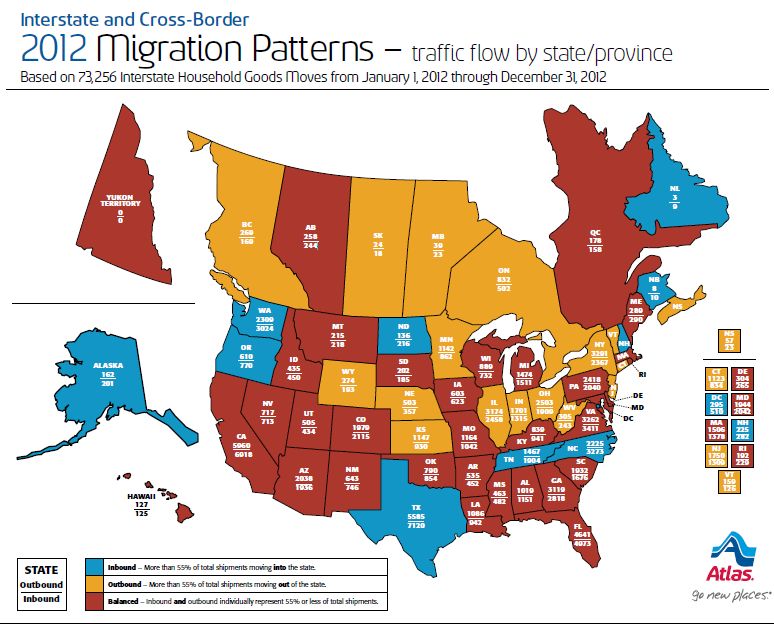
Where is America moving? Atlas Van Lines announces 2012 migration trends
10 states shift to balanced states; Popular destinations remain Southwest and Mid-Atlantic Coastal States
January 1, 2013
Media Contacts:
Kerri Hart, Atlas Van Lines
800.638.9797, ext. 2951 or hartk@atlasworldgroup.com
Greta Snell, Dittoe Public Relations
317.202.2280, ext. 18 or greta@dittoepr.com
EVANSVILLE, Ind. — According to one of the nation’s leading movers, Atlas Van Lines, there have been more shifts from inbound and outbound to balanced states in 2012. The 2012 Atlas Van Lines Migration Patterns study found Southwestern and Mid-Atlantic coastal states remain as the most popular destinations, while the Midwest becomes more balanced than years past. Atlas first conducted the study in 1993 to track the nation’s interstate moving patterns.
Six states that were outbound in 2011 are now balanced states, including Massachusetts, Delaware, Louisiana, Missouri, Utah and Wisconsin. Four states that were inbound have shifted into balanced states this year, including Maryland, New Mexico, Rhode Island and Virginia. Wyoming is outbound again after spending 2011 as a balanced state. Previously balanced state New Hampshire is inbound again.
The highest number of moves occurred in California, Texas and Florida. California comes in at the top with nearly 13,000 moves in 2012. For the seventh consecutive year, Washington D.C. had the highest percentage of inbound moves, with 63 percent of all moves being inbound. Nebraska and New York beat out Ohio for the highest percentage of outbound moves, with outbound moves accounting for 58 percent of each state’s total.
“This year’s annual Migration Patterns study revealed some interesting changes from 2011’s overall and regional trends,” said Jack Griffin, president and COO of Atlas World Group. “One of the more positive signs of 2012’s results is the shift from the majority of Midwestern states being outbound to a more balanced state. The increase in the number of balanced states/provinces throughout the U.S. and Canada is a promising sign that the economy could be stabilizing.”
In 2012, the total number of interstate, or between states, and inter-province moves reached 73,256. In addition, regional trends show consistency over the past year with fewer significant shifts:
Northern States
The Northern states saw no changes from 2011 to 2012. New York and New Jersey have been outbound for more than 10 years, with Pennsylvania remaining balanced for more than 10 years. Washington DC is the only northern location with more than 10 years on the inbound list.
Southern States
The Southeast remains balanced. Southwest states Texas and New Mexico continue to be inbound states, as well as Mid-Atlantic states Virginia and North Carolina. Kentucky remains balanced after becoming a newly inbound state in 2010 and moving back to balanced in 2011.
Midwestern States
After 2011 showed the majority of its states with more outbound than inbound moves, the Midwest region now has five balanced states – Wisconsin, Iowa, South Dakota, Missouri and Michigan. Indiana, Illinois, Ohio, Kansas, Minnesota and Nebraska remain outbound. Indiana has been an outbound state for more than 11 consecutive years. No Midwestern state has been classified as inbound for more than 10 years.
Western States
The annual study shows that the majority of the Western states remain balanced. Only two states are inbound or outbound – Utah (outbound) and New Mexico (inbound). California has now been balanced for more than 10 consecutive years.
Canadian Provinces
Of the 10 provinces, five are outbound – British Columbia, Manitoba, Nova Scotia, Ontario and Saskatchewan. Alberta breaks its five-year streak as an outbound province, while Quebec moves back to a balanced province. New Brunswick, who has been balanced for three consecutive years, is now inbound. All three territories – Nunavut, Northwest Territories and Yukon Territory – are unclassified; Nunavut was outbound in 2011 and the Northwest Territories was balanced.
How status is determined
Each state’s or province’s status is determined by its threshold value, which is the total number of shipments multiplied by 0.55 (i.e., in a state with 100 moves, at least 55 must be outgoing to be considered outbound). All other states or provinces in which outbound or inbound numbers don’t exceed the threshold are classified as balanced. Shipments noted for Canada are cross-border to the U.S. or from the U.S. (not inter-provincial).
To view full results of the 2012 migration patterns, a map and annual histories for each state, visit www.atlasvanlines.com/migration-patterns/. For an infographic on the results, visit www.atlasvanlines.com/infographics/2012-migration-patterns/.
About Atlas Van Lines
Atlas Van Lines, a national moving company, is the largest subsidiary of Atlas World Group, an Evansville, Ind.-based company. Atlas World Group companies employ nearly 700 people throughout North America. Nearly 500 Atlas interstate moving agents in the United States and Canada specialize in corporate relocation, household moving services and in the transportation of high-value items such as electronics, fine art, store fixtures and furniture. For more information, visit www.atlasvanlines.com.

